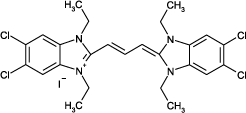JC-1 is widely used for determining mitochondrial membrane potential by flow cytometry, fluorescence microscopy and in microplate-based fluorescent assays. JC-1 accumulates in mitochondria, selectively generating an orange J-aggregate emission profile (590 nm) in healthy cells. However, upon cell injury, as membrane potential decreases, JC-1 monomers are generated, resulting in a shift to green emission (529 nm). The principal advantage of JC-1 relative to other commonly employed fluorescent probes of mitochondrial membrane potential is that it allows for both qualitative visualization, considering the shift from orange to green fluorescence emission, and quantitative detection, considering the fluorescence intensity ratio. Wavelength Maxima: Excitation 515nm, Emission 529nm
Product Details
| Alternative Name: | 5,5’,6,6’-Tetrachloro-1,1’,3,3’-tetraethylbenzimidazolylcarbocyanine iodide |
| |
| Formula: | C25H27Cl4IN4 |
| |
| MW: | 652.2 |
| |
| CAS: | 3520-43-2 |
| |
| Purity: | ≥95% (TLC) |
| |
| Solubility: | Soluble in DMSO. |
| |
| Shipping: | Ambient Temperature |
| |
| Long Term Storage: | -20°C |
| |
| Use/Stability: | Stable for at least one year after receipt when stored as recommended. |
| |
| Handling: | Protect from light. Keep cool and dry. |
| |
| Technical Info/Product Notes: | This product is a member of the CELLESTIAL® product line, reagents and assay kits comprising fluorescent molecular probes that have been extensively benchmarked for live cell analysis applications. CELLESTIAL® reagents and kits are optimal for use in demanding imaging applications, such as confocal microscopy, flow cytometry and HCS, where consistency and reproducibility are required. |
| |
| Regulatory Status: | RUO - Research Use Only |
| |
Please mouse over
Product Literature References
Growth Dynamic and Threshold Values for Spermicidal Effects of Multidrug-Resistant Bacteria in Extended Boar Semen: A.M. Luther, et al.; Microorganisms
11, 788 (2023),
Abstract;
Influence of the Fatty Acid Metabolism on the Mode of Action of a Cisplatin(IV) Complex with Phenylbutyrate as Axial Ligands: T. Mendrina, et al.; Pharmaceutics
15, 677 (2023),
Abstract;
Luminal H2O2 promotes ER Ca2+ dysregulation and toxicity of palmitate in insulin-secreting INS-1E cells: S. Sharifi, et al.; FASEB J.
37, e22685 (2023),
Abstract;
Otoprotective Effects of Fucoidan Reduce Cisplatin-Induced Ototoxicity in Mouse Cochlear UB/OC-2 Cells: C.Y. Hsieh, et al.; Int. J. Mol. Sci.
24, 3561 (2023),
Abstract;
11, 12-Diacetyl-carnosol Protects SH-SY5Y Cells from Hydrogen Peroxide Damage through the Nrf2/HO-1 Pathway: Q. Luo, et al.; Evid. Based Complement. Alternat. Med.
2022, 4376812 (2022),
Abstract;
Bisdemethoxycurcumin-mediated Attenuation of Apoptosis Prevents Gentamicin-induced Ototoxicity in Mouse Cochlear UB/OC-2 Cells: T.Y. Kang, et al.; In Vivo
36, 1095 (2022),
Abstract;
Dichloroacetate as a metabolic modulator of heart mitochondrial proteome under conditions of reduced oxygen utilization: N.B. Andelova, et al.; Sci. Rep.
12, 16348 (2022),
Abstract;
Entourage effect for phenolic compounds on production and metabolism of mammary epithelial cells: Y. Shalev, et al.; Heliyon
8, e09025 (2022),
Abstract;
UVR-induced phototoxicity mechanism of methyl N-methylanthranilate in human keratinocyte cell line: S. Chandra, et al.; Toxicol. In Vitro
80, 105322 (2022),
Abstract;
Adipose saturation reduces lipotoxic systemic
inflammation and explains the obesity paradox: B. Khatua, et al.; Sci. Adv.
7, 6449 (2021),
Abstract;
Cyclic AMP-binding protein Epac1 acts as a metabolic sensor to promote cardiomyocyte lipotoxicity: M. Laudette, et al.; Cell Death Dis.
12, 4149 (2021),
Abstract;
Ginsenoside Re Attenuates High Glucose-Induced RF/6A Injury via Regulating PI3K/AKT Inhibited HIF-1α/VEGF Signaling Pathway: W. Xie, et al.; Front. Pharmacol.
11, 1312 (2021),
Abstract;
Mitochondrial dysfunction and apoptosis are attenuated through activation of AMPK/GSK-3β/PP2A pathway in Parkinson’s disease: J. Su, et al.; Eur. J. Pharmacol.
907, 174202 (2021),
Abstract;
Mitochondrial protective effects of PARP-inhibition in hypertension-induced myocardial remodeling and in stressed cardiomyocytes: K. Ordog, et al.; Life Sci.
268, 118936 (2021),
Abstract;
Small molecule inhibitors of the mitochondrial ClpXP protease possess cytostatic potential and re-sensitize chemo-resistant cancers: M. Meßner, et al.; Sci. Rep.
11, 11185 (2021),
Abstract;
Full Text
Altered mitochondrial quality control in Atg7-deficient VSMCs promotes enhanced apoptosis and is linked to unstable atherosclerotic plaque phenotype: H. Nahapetyan, et al.; Cell Death Dis.
10, 119 (2019),
Application(s): mitochondrial potential measurement in transgenic mice model,
Abstract;
Full Text
Inhibition of MAPKinase pathway sensitizes thyroid cancer cells to ABT-737 induced apoptosis: V. Gunda, et al.; Cancer Lett.
395, 1 (2017),
Abstract;
Cytotoxicity of methanol extracts of Annona muricata, Passiflora edulis and nine other Cameroonian medicinal plants towards multi-factorial drug-resistant cancer cell lines: V. Kuete, et al.; Springerplus
5, 1666 (2016),
Application(s): Analysis of mitochondrial membrane potential (MMP),
Abstract;
Full Text
Oxidative stress plays major role in mediating apoptosis in filarial nematode Setaria cervi in the presence of trans-stilbene derivatives: N. Mukherjee, et al.; Free. Radic. Biol. Med.
93, 130 (2016),
Application(s): Cell culture,
Abstract;
Aralar plays a significant role in maintaining the survival and mitochondrial membrane potential of BV2 microglia: C. Wang, et al.; Int. J. Physiol. Pathophysiol. Pharmacol.
7, 107 (2015),
Application(s): Flow cytometry-based JC-1 assay,
Abstract;
Full Text
ATP-induced cellular stress and mitochondrial toxicity in cells expressing purinergic P2X7 receptor: S. Seeland, et al.; Pharma. Res. Per.
3, e00123 (2015),
Application(s): Cell Culture, Fluorescence Microscopy,
Abstract;
Full Text
Circumvention of cisplatin resistance in ovarian cancer by combination of cyclosporin A and low-intensity ultrasound: T. Yu, et al.; Eur. J. Pharm. Biopharm.
91, 103 (2015),
Application(s): Flow Cytometry,
Abstract;
Full Text
Retinol binding protein 4 induces mitochondrial dysfunction and vascular oxidative damage: J. Wang, et al.; Atherosclerosis
240, 335 (2015),
Application(s): Cell Culture,
Abstract;
Mitochondrial membrane potential monitored by JC-1 dye: M. Reers, et al.; Methods Enzymol.
260, 406 (1995),
Abstract;













